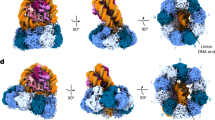Abstract
Explaining the determinants involved in regulating the equilibrium between different chromatin structural states is fundamental to understanding differential gene expression. Histone variant H2A.Z is essential to chromatin architecture in higher eukaryotes but its role has not yet been explained. We show here that H2A.Z facilitates the intramolecular folding of nucleosomal arrays while simultaneously inhibiting the formation of highly condensed structures that result from intermolecular association. This makes a case for H2A.Z playing a fundamental role in creating unique chromatin domains poised for transcriptional activation. These results provide new insights into understanding how chromatin fiber dynamics can be altered by core histone variants to potentially regulate genomic function.
This is a preview of subscription content, access via your institution
Access options
Subscribe to this journal
Receive 12 print issues and online access
$189.00 per year
only $15.75 per issue
Buy this article
- Purchase on Springer Link
- Instant access to full article PDF
Prices may be subject to local taxes which are calculated during checkout




Similar content being viewed by others
References
Strahl, B.D. & Allis, C.D. Nature 403, 41–45 (2000).
Jackson, J.D. & Gorovsky, M.A. Nucleic Acids Res. 28, 3811–3816 (2000).
van Daal, A. & Elgin, S.C. Mol. Biol. Cell 3, 593–602 (1992).
Liu, X., Li, B. & Gorovsky, M.A. Mol. Cell. Biol. 16, 4305–4311 (1996).
Faast, R. et al. Current Biol. 11, 1183–1187 (2001).
Clarkson, M.J., Wells, J.R., Gibson, F., Saint, R. & Tremethick, D.J. Nature 399, 694–697 (1999).
Suto, R.K., Clarkson, M.J., Tremethick, D.J. & Luger, K. Nature Struct. Biol. 7, 1121–1124 (2000).
Fletcher, T.M. & Hansen, J.C. J. Biol. Chem. 270, 25359–25362 (1995).
Carruthers, L.M., Bednar, J., Woodcock C.L. & Hansen, J.C. Biochemistry 37, 14776–14787 (1998).
Tse, C. & Hansen, J.C. Biochemistry 36, 11381–11388 (1997).
Carruthers, L.M. & Hansen, J.C. J. Biol. Chem. 275, 37285–37290 (2000).
Fletcher, T.M. & Hansen, J.C. Crit. Rev. Eukaryot. Gene Expr. 6, 149–188 (1996).
Tse, C., Sera,T., Wolffe, A.P. & Hansen, J.C. Mol. Cell. Biol. 18, 4629–4638 (1998).
Pollard, K.J., Samuels, M.L., Crowley, K.A., Hansen, J.C. & Peterson, C.L. EMBO J. 18, 5622–5633 (1999).
Schwarz, P.M. & Hansen, J.C. J Biol. Chem. 269, 16284–16289 (1994).
Hansen, J.C., Ausio, J., Stanik, V.H. & van Holde, K.E. Biochemistry 28, 9129–9136 (1989).
Hebbes, T.R. Clayton, A.L., Thorne, A.W. & Crane-Robinson, C. EMBO J. 13, 1823–1830 (1994).
Stargell, L.A. et al. Genes Dev. 7, 2641–2651 (1993).
Waterborg, J.H. J. Biol. Chem. 275, 13007–13011 (2000).
Santisteban, M.S., Kalashnikova, T. & Smith, M.M. Cell 103, 411–422 (2000).
Leach, T.J., et al. J. Biol. Chem. 275, 23267–23272 (2000).
Dhillon, N. & Kamakaka, R.T. Mol. Cell 6, 769–780 (2000).
Abbott, D.W., Ivanova, V.S., Wang, X., Bonner, W.M. & Ausio, J. J. Biol. Chem. 276, 41945–41949 (2001).
Li, W., Nagaraja, S., Delcuve, G.P., Hendzel, M.J. & Davie, J.R. Biochem. J. 296, 737–744 (1993).
Luger, K., Rechsteiner, T.J. & Richmond, T. J. Methods Enzymol. 304, 3–19 (1999).
Hansen, J.C. & Lohr, D. J. Biol. Chem. 268, 5840–5848 (1993).
Acknowledgements
This work was supported by a Human Frontier Science Program grant to K.L. and D.J.T., and an NIH grant to J.C.H.
Author information
Authors and Affiliations
Corresponding author
Ethics declarations
Competing interests
The authors declare no competing financial interests.
Rights and permissions
About this article
Cite this article
Fan, J., Gordon, F., Luger, K. et al. The essential histone variant H2A.Z regulates the equilibrium between different chromatin conformational states. Nat Struct Mol Biol 9, 172–176 (2002). https://doi.org/10.1038/nsb767
Received:
Accepted:
Published:
Issue Date:
DOI: https://doi.org/10.1038/nsb767
This article is cited by
-
The conserved histone variant H2A.Z illuminates meiotic recombination initiation
Current Genetics (2018)
-
Proteins interacting with CreA and CreB in the carbon catabolite repression network in Aspergillus nidulans
Current Genetics (2017)



